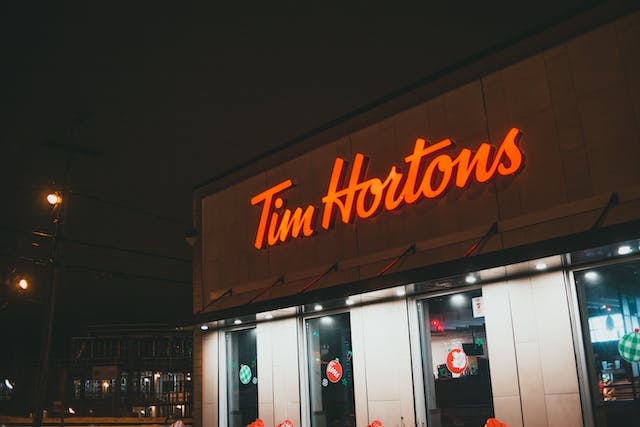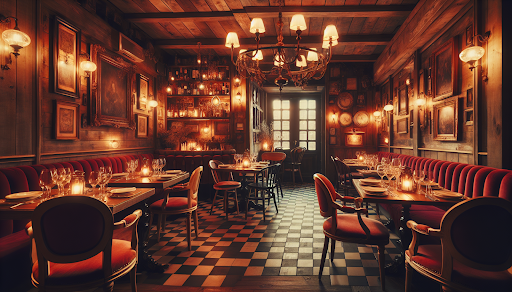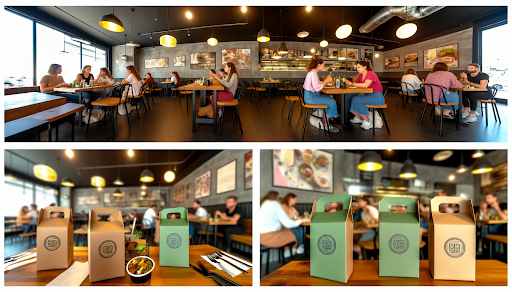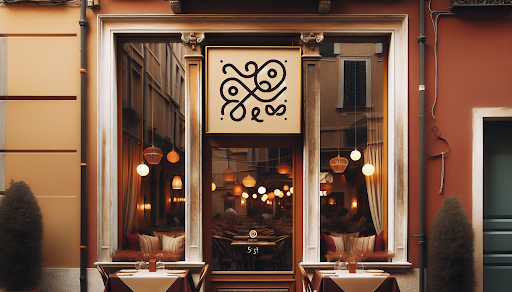Crafting Your Identity: Top Strategies for Successful Restaurant Branding
By Steffen Andersen · 10. January 2024
What makes restaurant branding essential?
With the array of choices available to diners, forging a unique identity through effective branding strategies can be the deciding factor in the success 🏆of your restaurant.
This article offers a comprehensive guide to crafting a coherent brand experience that resonates with guests, ensuring your restaurant not only captures attention but also retains a loyal following.
Explore elements of interior design, packaging, social media engagement, and more as you journey towards creating a standout brand.
Key Takeaways
- Strong restaurant branding involves creating a comprehensive brand identity that reflects the restaurant’s values, personality, and experience, not just a catchy name or logo.
- A restaurant’s brand extends to its interior design, which should be consistent with its brand image, and takeaway packaging, promoting brand recognition and values even outside the dining experience.
- Regular evaluation and adaptation of branding strategies are essential for relevance, leveraging tools like social media interaction, customer feedback, and local partnerships to engage customers and community.
Understanding Restaurant Branding

Restaurant branding is not merely about a catchy name or an intriguing logo.
It is a comprehensive process that shapes the restaurant brand identity, encompassing its values, brand’s personality, and the overall experience it offers.
An effective restaurant logo, for instance, is meticulously crafted to reflect the restaurant’s distinct taste and personality, thereby leaving a lasting impact and connecting with its specific audience.
Strong restaurant branding is crucial in standing out 🌟 in the crowded restaurant market and fostering a loyal clientele. This is achieved through effective brand positioning.
It is a strategic approach employed to differentiate a restaurant within the perceptions of its intended clientele, thereby defining the restaurant’s unique position in the competitive market.
The design of your restaurant is a key factor in attracting customers and providing a brand-aligned experience.
From the interior decor to the menu design, every aspect contributes to building a strong restaurant brand.
Defining Your Restaurant’s Brand
Building a successful restaurant brand begins by addressing basic questions about your restaurant’s values and operational strategies. Here are some key questions to consider:
- What is the demographic you are trying to reach with your message? It’s important to understand who your target audience is in order to effectively communicate with them.
- What is your unique selling proposition?
- What is your restaurant’s mission?
These factors are pivotal in shaping your brand identity and brand personality, which together form your overall strategy.
Understanding your target audience facilitates effective communication and customization of services to align with their expectations.
Moreover, highlighting your unique selling point (USP) serves as the primary attraction for customers to choose your restaurant over others, thereby fostering brand loyalty.
The restaurant’s brand voice🗣️ should mirror your restaurant’s mission and principles while addressing the specific needs and expectations of your target audience.
It influences various elements of your branding strategy, from your social media presence to your menu descriptions.
Additionally, performing a competitor analysis aids in identifying market gaps that can be leveraged to differentiate your restaurant, thereby creating a cohesive visual brand.
Interior Design: Creating a Memorable Atmosphere

A restaurant’s interior design plays a significant role in restaurant branding by creating a memorable ambiance and enhancing the dining experience.
The selected color palette, typography, and imagery present in the restaurant’s interior design serve to convey the brand’s identity and establish a visual harmony linked to the brand’s character.
This cohesive presentation contributes to the restaurant’s visual identity, which is crucial for a successful brand image.
Lighting fixtures carry a dual role in creating a desirable atmosphere. Besides their functional necessity, they evoke different moods, adding to the aesthetic appeal of the restaurant.
Decorative elements are not merely for visual appeal; they should emphasize your brand’s core identity, creating an experience that leaves a lasting impression on the patrons and potentially encourages social media sharing.
Developing a unified interior design that mirrors your brand requires maintaining brand consistency and choosing design elements that align with your restaurant’s personality and values.
This systematic integration of branding into the tangible aspects of the dining experience contributes to building a sustainable restaurant 🏠🍽️ business.
Takeaway Packaging: Extending Your Brand Beyond the Dining Experience

In the era of food delivery and takeout, takeaway packaging is a unique opportunity to extend the reach of your brand beyond the dining setting, reinforcing the brand’s identity and values.
The packaging should include elements like:
- Your restaurant’s logo
- Brand colors
- Social media profiles
- Website
The most important part about choosing what should be shown on your takeaway packaging is that it is consistent with your interior design, your restaurant concept & in general the overall perception of your restaurant.
Every time a customer carries your branded packaging, it catches the attention of potential new customers and sparks curiosity about your restaurant.
It’s like a walking billboard, promoting 📢 your restaurant’s brand identity and values wherever it goes.
Moreover, a well-designed takeaway packaging can encourage customers to share their dining experience on social media.
By incorporating your restaurant’s logo, brand colors, and social media profiles on your packaging, you are essentially creating a photo-ready package that customers would love to snap a picture of and share on their social media platforms.
Showcasing Your Brand on Instagram: Interior Design and Takeaway Packaging
 Restaurant Interior Design and Takeaway Packaging
Restaurant Interior Design and Takeaway Packaging
With social media becoming increasingly central in our lives, showcasing your restaurant’s interior design and takeaway packaging on platforms like Instagram can effectively engage with your audience, raise brand awareness🚀, and draw in new customers.
Capturing appealing images of your restaurant interiors involves focusing on:
- Lighting
- Capturing movements
- Holding the phone level
- Shooting in natural daylight
Instagram Stories is another effective tool to showcase your restaurant’s brand. You can create Story Highlights on your profile, selecting stories that demonstrate various aspects of your brand, like:
- products
- announcements
- resources
- events
- behind-the-scenes footage
- staff interviews
- competitions
- collaborations with other businesses
Crafting a Consistent Visual Identity

Crafting a uniform visual identity across various touchpoints is vital for developing a unified and identifiable brand. This includes:
- Logo
- Typography
- Color palette
- Imagery
Typography plays a significant part in forming the overall impression of the brand. It encompasses the selection of fonts and their application across various design materials.
Considering the brand voice and customer preferences is important when selecting typography to ensure it aligns with the overall brand messaging.
A brand style guide is a comprehensive document that outlines the various elements of a restaurant’s brand identity, offering directives for their uniform application across all points of interaction, thereby guaranteeing a cohesive representation of the brand.
Engaging Your Audience Through Social Media
Social media is a potent tool for both establishing a restaurant brand’s identity and connecting with customers, thus expanding the customer base.
Restaurants can use platforms like Instagram, Facebook, and Twitter to exhibit their brand’s identity, disseminate information to their audience, and interact with customers by organizing contests, reusing user-generated content, and employing localized and tourist-targeted ads.
Content that typically elicits high engagement involves high-quality photographs📷 and videos📹 showcasing menu items, innovative use of food-related hashtags, and interactive features like polls.
These strategies further the restaurant’s branding efforts and foster a sense of community among the customers.
Building Customer Loyalty with Exceptional Service
Customer loyalty is a fundamental component of restaurant branding.
Exceptional service cultivates trust and conveys a sense of respect to customers, thereby contributing to a consistent brand experience that reflects the restaurant’s identity.
To ensure brand values are embodied in service, restaurant staff should be trained with:
- Clear communication of the brand message during orientation and follow-up training sessions
- Real examples of desired behaviors
- A values-driven hiring process
- Fostering open, honest communication
Restaurants that provide a superior ambiance and menu, maintain sufficient waitstaff presence, and establish a favorable overall customer experience are the ones that customers are enthusiastic to endorse.
A loyal customer base is a valuable asset to any restaurant, as they not only provide repeat business but also serve as brand ambassadors, spreading positive word-of-mouth.
Collaborating with Local Partnerships
Collaborating with local partnerships, such as suppliers, events, and other businesses, can strengthen your restaurant’s brand.
Such collaborations showcase your commitment to the community and foster mutually beneficial relationships.
Restaurants can collaborate with local suppliers, neighboring businesses, community organizations, and co-marketing partners for mutual promotion.
One creative branding strategy involving community engagement is to partner with other local businesses for mutual promotion and to establish a memorable presence in the community.
These collaborations not only enhance your brand’s visibility but also establish your restaurant as a community-centric business.
Evaluating and Evolving Your Brand Strategy
Consistently evaluating and improving your branding efforts are vital in maintaining their relevance and effectiveness in drawing in and retaining customers. Key🔑 performance indicators such as:
- Sales
- Historical sales
- Labor cost
- Cost of goods
- Prime cost
Help assess the effectiveness of a restaurant’s mission and successful restaurant branding ideas strategy.
Customer feedback plays a significant role in enhancing a restaurant’s brand strategy. It provides valuable insights into customer preferences and experiences, which can be used to refine and improve your branding efforts.
In light of evolving consumer preferences, it’s vital to adapt and modify your branding strategy to stay relevant. Here are some ways to do that:
- Implement a comprehensive digital marketing strategy
- Adjust to evolving consumer behaviors
- Maintain a prominent online presence
- Make environmentally conscious decisions
Summary
In conclusion, crafting a successful restaurant brand is an ongoing process that involves understanding and defining your brand, creating a memorable atmosphere through interior design, extending your brand through takeaway packaging, showcasing your brand on Instagram, crafting a consistent visual identity, engaging your audience through social media, building customer loyalty with exceptional service, collaborating with local partnerships, and continually evaluating and evolving your brand strategy.
By investing in your branding efforts, you can create a unique and compelling restaurant brand that resonates with your target audience and stands out in the competitive restaurant industry.

